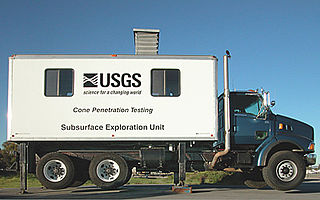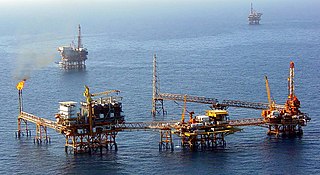Related Research Articles

A time-domain reflectometer (TDR) is an electronic instrument used to determine the characteristics of electrical lines by observing reflected pulses.

The cone penetration or cone penetrometer test (CPT) is a method used to determine the geotechnical engineering properties of soils and delineating soil stratigraphy. It was initially developed in the 1950s at the Dutch Laboratory for Soil Mechanics in Delft to investigate soft soils. Based on this history it has also been called the "Dutch cone test". Today, the CPT is one of the most used and accepted soil methods for soil investigation worldwide.

Water content or moisture content is the quantity of water contained in a material, such as soil, rock, ceramics, crops, or wood. Water content is used in a wide range of scientific and technical areas, and is expressed as a ratio, which can range from 0 to the value of the materials' porosity at saturation. It can be given on a volumetric or mass (gravimetric) basis.

A rheometer is a laboratory device used to measure the way in which a viscous fluid flows in response to applied forces. It is used for those fluids which cannot be defined by a single value of viscosity and therefore require more parameters to be set and measured than is the case for a viscometer. It measures the rheology of the fluid.
The California Bearing Ratio (CBR) is a measure of the strength of the subgrade of a road or other paved area, and of the materials used in its construction.
The Atterberg limits are a basic measure of the critical water contents of a fine-grained soil: its shrinkage limit, plastic limit, and liquid limit.
Moisture vapor transmission rate (MVTR), also water vapor transmission rate (WVTR), is a measure of the passage of water vapor through a substance. It is a measure of the permeability for vapor barriers.
The Fall cone test, also called the cone penetrometer test or the Vasiljev cone test, is an alternative method to the Casagrande method for measuring the Liquid Limit of a soil sample proposed in 1942 by the Russian researcher Piotr Vasiljev and first mentioned in the Russian standard GOST 5184 from 1949. It is often preferred to the Casagrande method because it is more repeatable and less variable with different operators. Other advantages of the fall cone test include the alternative to estimate the undrained shear strength of a soil based on the fall cone factor K.
Level sensors detect the level of liquids and other fluids and fluidized solids, including slurries, granular materials, and powders that exhibit an upper free surface. Substances that flow become essentially horizontal in their containers because of gravity whereas most bulk solids pile at an angle of repose to a peak. The substance to be measured can be inside a container or can be in its natural form. The level measurement can be either continuous or point values. Continuous level sensors measure level within a specified range and determine the exact amount of substance in a certain place, while point-level sensors only indicate whether the substance is above or below the sensing point. Generally the latter detect levels that are excessively high or low.
The thermal properties of soil are a component of soil physics that has found important uses in engineering, climatology and agriculture. These properties influence how energy is partitioned in the soil profile. While related to soil temperature, it is more accurately associated with the transfer of energy throughout the soil, by radiation, conduction and convection.

Geotechnical investigations are performed by geotechnical engineers or engineering geologists to obtain information on the physical properties of soil earthworks and foundations for proposed structures and for repair of distress to earthworks and structures caused by subsurface conditions; this type of investigation is called a site investigation. Geotechnical investigations are also used to measure the thermal resistance of soils or backfill materials required for underground transmission lines, oil and gas pipelines, radioactive waste disposal, and solar thermal storage facilities. A geotechnical investigation will include surface exploration and subsurface exploration of a site. Sometimes, geophysical methods are used to obtain data about sites. Subsurface exploration usually involves soil sampling and laboratory tests of the soil samples retrieved.

Nuclear densitometry is a technique used in civil construction and the petroleum industry, as well as for mining and archaeology purposes, to measure the density and inner structure of the test material. The processes uses a nuclear density gauge, which consists of a radiation source that emits particles and a sensor that counts the received particles that are either reflected by the test material or pass through it. By calculating the percentage of particles that return to the sensor, the gauge can be calibrated to measure the density.

Soil moisture sensors measure the volumetric water content in soil. Since the direct gravimetric measurement of free soil moisture requires removing, drying, and weighing of a sample, soil moisture sensors measure the volumetric water content indirectly by using some other property of the soil, such as electrical resistance, dielectric constant, or interaction with neutrons, as a proxy for the moisture content.

Capacitive displacement sensors are "non-contact devices capable of high-resolution measurement of the position and/or change of position of any conductive target". They are also able to measure the thickness or density of non-conductive materials. Capacitive displacement sensors are used in a wide variety of applications including semiconductor processing, assembly of precision equipment such as disk drives, precision thickness measurements, machine tool metrology and assembly line testing. These types of sensors can be found in machining and manufacturing facilities around the world.

Package testing or packaging testing involves the measurement of a characteristic or property involved with packaging. This includes packaging materials, packaging components, primary packages, shipping containers, and unit loads, as well as the associated processes.
The nutrient content of a plant can be assessed by testing a sample of tissue from that plant. These tests are important in agriculture since fertilizer application can be fine-tuned if the plants nutrient status is known. Nitrogen most commonly limits plant growth and is the most managed nutrient.

Offshore geotechnical engineering is a sub-field of geotechnical engineering. It is concerned with foundation design, construction, maintenance and decommissioning for human-made structures in the sea. Oil platforms, artificial islands and submarine pipelines are examples of such structures. The seabed has to be able to withstand the weight of these structures and the applied loads. Geohazards must also be taken into account. The need for offshore developments stems from a gradual depletion of hydrocarbon reserves onshore or near the coastlines, as new fields are being developed at greater distances offshore and in deeper water, with a corresponding adaptation of the offshore site investigations. Today, there are more than 7,000 offshore platforms operating at a water depth up to and exceeding 2000 m. A typical field development extends over tens of square kilometers, and may comprise several fixed structures, infield flowlines with an export pipeline either to the shoreline or connected to a regional trunkline.

A TDR moisture sensor employs time-domain reflectometry (TDR) to measure moisture content indirectly based on the correlation to electric and dielectric properties of materials, such as soil, agrarian products, snow, wood or concrete.

The Nippon Screw Weight System (NSWS) is an on-site ground survey machine that examines the geotechnical engineering properties of soil. The NSWS was developed to encounter weather abnormalities and natural hazards, saving human lives.
The lunar penetrometer was a spherical electronic tool that served to measure the load-bearing characteristics of the Moon in preparation for spacecraft landings. It was designed by NASA to be dropped onto the surface from a vehicle orbiting overhead and transmit information to the spacecraft. However, despite it being proposed for several lunar and planetary missions, the device was never actually fielded by NASA.
References
- ↑ "JOCKEY CLUB ANNOUNCE INTRODUCTION OF NEW DEVICE FOR MEASUREMENT OF GOING". British Horseracing Authority. Retrieved 7 May 2024.
- ↑ "Fruit Ripeness Testing by Wagner Instruments". Fruit Test.
- ↑ "Foods: Experimental Perspectives, 8th Edition Margaret McWilliams, Ph.D., R.D., Professor Emeritus, California State University, Los Angeles, 2017, Pearson".
{{cite web}}: Missing or empty|url=(help)